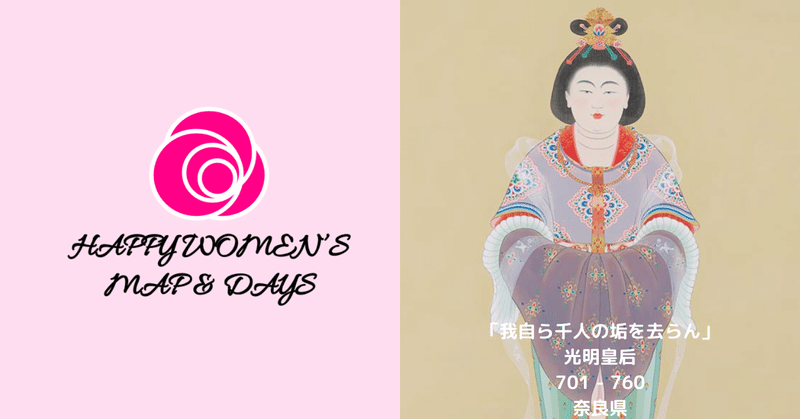
Happy Women's Map 奈良県 日本初の孤児院開設 光明皇后

光明皇后 Empress Komyo
701 - 760
奈良県奈良市佐紀町
Born in Saki-machi, Nara-city, Nara-ken
「我自ら千人の垢を去らん」
"I shall cleanse myself of the impurities of a thousand people."
光明皇后は日本で初めて薬局・病院・孤児院・風呂を開設、庶民に開かれた福祉施設の原点をカタチづくりました。
Empress Komyo is the first in Japan to establish pharmacies, orphanages, and public baths, laying the foundation for welfare facilities accessible to common people.
********
光明子は官職を独占する藤原氏一族筆頭の藤原不比等と、乳母・養育係として宮仕えをする県犬養橘三千代の三女として生まれ、入内した異母姉妹の生んだ首皇子のもとに15歳で入内します。26歳の時に待望の基皇子は1年で夭折します。首皇子のもう一人の夫人が安積親王を出産。翌年、藤原一族はクーデターを起こし有力な皇位継承候補である長屋王一族を一掃。同年、光明子は民間出身初の皇后に立てられます。明皇后は即位と同時に、長屋王邸を取り潰して、皇后の家政機関として皇后宮職を設置、執政や社会事業を行う拠点としました。翌年、興福寺に施薬院・治者院・悲田院を設け、五重塔の建立します。施薬院は医師・鍼師らの医療に必要な薬草を諸国から買い集め、さらに自宅で保養できない病苦孤独者を治者院に収容し治療します。悲田院は乳母・養母が捨て子また孤児、また貧窮孤老者を労養世話します。ならびに法華寺を創建、自ら尼僧の仏学研鑚を勧めながら、薬草を用いた蒸し風呂、庶民のための「からふろ」を設けます。
光明皇后は、藤原一族と皇室の財産をつぎ込んで、福祉事業、写経事業、国分寺・国分尼寺・大仏建立を行います。これは、仏教信仰のみならず、中国史上唯一の女帝である則天武后に倣って自身の即位を正当化するために行っています。
またこの頃から、捨て子が急増します。というのも、父から子への官職の世襲制・夫を家長とする家制度が成立、女性たちは財産相続権利を奪われるとともに独立して生計を立てることが困難になります。さらに、世襲・家柄により社会的・公的身分が認知されるようになると、後継ぎの男子を生む女性が重要視され、働く女性は軽蔑視され始めます。ならびに、後継ぎの男子を育てる乳母また養育係に高い位と経済的保障が与えられ、女性のあこがれの職業となります。
Born as the third daughter of Fujiwara no Fuhito, the head of the influential Fujiwara clan, and Keno Inukai Tachibana Michiyo, who served as her nurse and caregiver, Komyo entered the imperial court at the age of 15 as one of the consorts of Prince Obito. At the age of 26, her long-awaited firstborn, Prince Motoi, passed away after only one year. Another consort of Prince Otsu gave birth to Prince Asaki. In the following year, a coup led by the Fujiwara clan eliminated the powerful rival for the imperial succession, the Nagaya-Okimi clan. In the same year, Komyo was appointed as the first empress from a commoner background.
Immediately after ascending the throne, Empress Komyo dissolved the Nagaya-Okimi residence and established the Empress's Court to serve as the administrative and social welfare center for the empress. The following year, she established the Sekiyakuin (Medicine Dispensary), Chisha-in (Physician's House), and Hitoda-in (Home for the Needy) within the Kofuku-ji Temple and erected a five-story pagoda. The Sekiyakuin collected medicinal herbs from various provinces for medical practitioners and acupuncturists, while the Chisha-in accommodated and treated those who could not care for themselves due to illness and loneliness. The Hitoda-in took care of abandoned children, orphans, and elderly people in poverty. Additionally, she founded the Hokke-ji Temple and provided public baths using herbal steam, known as "karaburo," for the common people, while encouraging herself and other nuns to study Buddhist teachings.
Empress Komyo invested the assets of the Fujiwara clan and the imperial family into welfare, copying the example of Empress Wu Zetian, the only female emperor in Chinese history, to justify her own reign. Around this time, the number of abandoned children increased. This was due to the establishment of a hereditary system of official positions from father to son and a household system where the husband became the head of the family. Consequently, women lost their rights to inherit property and found it difficult to support themselves independently. Moreover, social and public status began to be recognized based on heredity and family background, emphasizing the importance of giving birth to male successors. Working women started to be looked down upon, while high-ranking positions and economic security were given to wet nurses and caregivers raising male heirs, becoming coveted professions for women.
-宮内庁 Imperial House hold Agency
-国立国会図書館 National Diet Library of Japan
-総国分尼寺法華寺 Hokkeji
Share Your Love and Happy Women's Story!
あなたを元気にする女性の逸話をお寄せください!
Share your story of a woman that inspires you!

この記事が気に入ったらサポートをしてみませんか?
